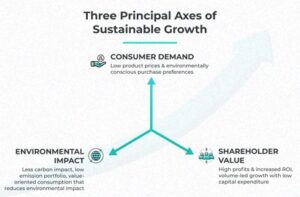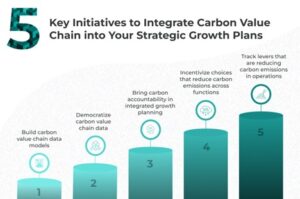Net Zero – a state in which carbon emissions are cut to a minimum – is not merely a climate goal or social imperative, but an opportunity to create value for Consumer-Packaged Goods (CPG) leaders. To limit the impact of climate change as outlined in the Paris Agreement, the world must achieve Net Zero goals by 2050. European regulations like the Corporate Sustainability Reporting Directive (CSRD) and Carbon Border Adjustment Mechanism (CBAM) make sustainability no longer optional, but an obligation.
The first half of this decade brought major challenges to CPG companies including COVID-19 market shocks, supply chain disruptions, and inflation-led weakness in consumer sentiment. In such turbulent times, companies have struggled to continue investing in sustainability initiatives. Despite progress on decarbonization, only 6% of CPG companies are on track to achieve their Net Zero targets by 2050 (Source: Accenture Destination Net Zero Report 2023).
As Gen Z consumers grow their purchasing power and increasingly prioritize environmental responsibility, sustainability will need to become core to the brand agenda for companies to stay competitive. Reducing emissions and balancing the rest through innovative carbon reduction strategies will define CPG industry leadership in the future. Brands will need to proactively integrate Net Zero goals into their business growth strategies to minimise their carbon cost of growth. For CPG companies, the focus needs to be on Scope 3 emissions (comprising ~90% of carbon emissions) which are poorly measured or managed. Scope 3 or indirect emissions involve emissions across procurement, supply chain, logistics, and commercialization.
To truly move the needle, it’s not enough for Chief Sustainability Officers (CSOs) to be solely responsible for meeting Net Zero goals. Achieving sustainability milestones must actively involve all functional leaders including marketing, sales, supply chain, and commercial officers. Additionally, CSOs must also be included in the business planning and decision-making processes along with other functional leaders to make sustainability an operational priority.
Why Net Zero Matters – The Carbon Value Chain of Growth
Companies must develop a carbon value chain of every element of their operations and incentivize functional leaders to factor it into their growth strategies. CPG companies should incorporate the carbon value chain into decision-making processes considering three principal axes of sustainable growth – consumer demand, shareholder value and environmental impact.
While growth strategies along two of the three axes are straightforward, sustainable progress across all three becomes challenging. Today, business function leaders overlook the commercial liability of ignoring carbon emissions in growth strategies. Companies that fail to follow regulations or achieve mandated goals face fines, hamper their growth, and risk losing the trust of environmentally conscious consumers, ultimately eroding long-term shareholder value.
Failing to align growth with Net Zero objectives can also lead to escalating future costs of voluntary carbon offsets. In the past, CPG companies were not only required to prioritize profits and revenue for shareholders but also build brand value by tapping into consumer preferences and purchase patterns. Now, they have to implement environmentally conscious business practices with low carbon impact, guided by a data-driven approach.
5 Key Initiatives to Integrate Carbon Value Chain into Your Strategic Growth Plans
- Build Carbon Value Chain Data Models: Collaborate with suppliers to estimate carbon emission across the business value chain along with attribution analysis combining multiple data sources. Create carbon value chain data models across Category, SKUs, Channels, and geographies that form the growth levers for the organization.
- Democratize Carbon Value Chain Data: Publish carbon value chain data and make it available for business stakeholders across all organizational verticals. Track functional initiatives that drive reduction and incentivize teams to achieve carbon reduction goals and integrate carbon cost updates as a key business metric.
- Bring Carbon Accountability in Integrated Growth Planning: Align carbon reduction plans with growth strategies, enhance cross-functional organizational cooperation to meet sustainability targets, and evaluate investment decisions based on carbon impact in addition to financial returns.
- Incentivize Choices that Reduce Carbon Emissions Across Functions: Marketing efforts should prioritize strategies that reduce carbon emissions across the portfolio. Companies should reduce their carbon footprint in high-impact areas – logistics, packaging and raw materials. Sales departments should develop low-emission commercial growth models and encourage eco-friendly practices among customers and partners.
- Track Levers that are Reducing Carbon Emissions in Operations: Track the low-emission, low carbon impact initiatives taken across functions, measure it regularly along with its effective impact and how much value it has added to the company. Integrate this into performance evaluations, rewards and recognitions, and other Human Resources metrics.
Leading the Charge on Net Zero Goals
Aligning with Net Zero isn’t just about compliance; it’s about future-proofing growth, driving innovation, and creating sustainable value for both the planet and your bottom line. An effective way to elevate Net Zero goals to business conversations is by integrating them into the overall growth strategy. To accelerate meeting these targets, it’s essential to shift from siloed accountability and reporting to cross-functional decision-making and democratization of data into operational and business reports. Embedding sustainability into decision-making processes, incentivizing functional leaders, and leveraging advanced analytics will drive responsible growth while ensuring long-term competitiveness in an evolving landscape. Net Zero isn’t just a goal, it’s the blueprint for future-focused growth.



